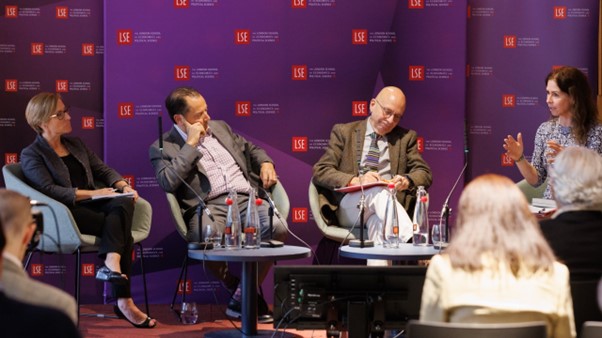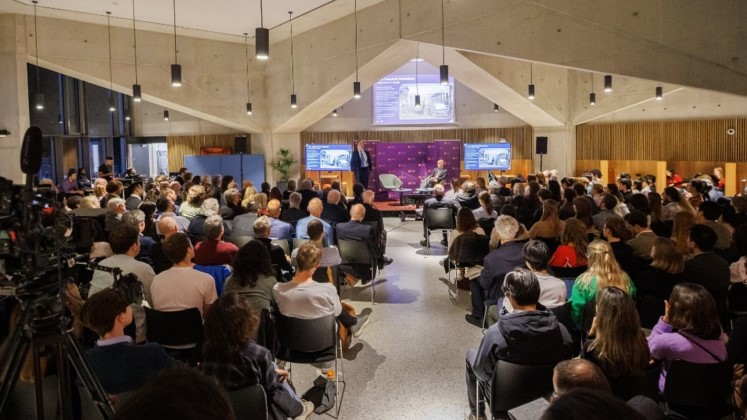 On Tuesday 21 May, the Phelan US Centre and the Mannheim Centre for Criminology co-hosted the launch of Dr Tony Cheng’s new book, ‘The Policing Machine: Enforcement, Endorsements & the Illusion of Public Input’. Alia Yusuf gives an overview of the event and the Q&A segment.
On Tuesday 21 May, the Phelan US Centre and the Mannheim Centre for Criminology co-hosted the launch of Dr Tony Cheng’s new book, ‘The Policing Machine: Enforcement, Endorsements & the Illusion of Public Input’. Alia Yusuf gives an overview of the event and the Q&A segment.
On 21 May, the Phelan US Centre and the Mannheim Centre for Criminology co-hosted the launch of the new book, The Policing Machine: Enforcement, Endorsements & the Illusion of Public Input (2023), by Dr Tony Cheng. Cheng is currently Assistant Professor of Sociology at Duke University and studies the politics and inequalities of policing. Chaired by Phelan US Centre Affiliate, Johann Koehler, of LSE’s Department of Social Policy, the event explored a glaring contradiction: while the police killings of the 2010s in the US sparked protests about the harms policing brings to minorities, policymakers responded by hiring even more police officers nationwide.
During the event Cheng explained how at the height of stop-and-frisk in New York City, the police were stopping around half a million people annually, disproportionately targeting innocent black and brown men. In response, community organizers protested this institutionalized form of racial injustice. Three days after the protests, a local television station invited Mr. Holloway, an older African American community member and long-time Brooklyn resident, for an interview. Unlike the protesters, Mr. Holloway agreed with the stop-and-frisk policy, believing that people no longer walked around in fear, while also acknowledging the ongoing presence of some malicious police officers.
Hidden from the public was the fact that Mr. Holloway had been president of a Precinct Community Council in Brooklyn for more than a decade. These resident-run boards, present in every New York City precinct, are designed to facilitate police-community relationships. As outlined in his book, Dr Cheng explained that this is one of the ways the New York Police Department (NYPD) can resist calls for change.
To dissect the NYPD’s strategy in resisting change despite escalating public scrutiny, Cheng uses qualitative methods such as ethnography, content analysis, and archival research. From his research, he found that although the police may want legitimacy in the public eye, they do not want it at the expense of their organizational independence. Balancing these objectives, the police seek to accumulate political capital by strategically distributing public resources, applying regulatory leniency, and using coercive force. Dubbed ‘the policing machine,’ this three-way strategy ultimately creates the illusion of public input.
By directing public complaints towards its own channels, such as Community Council meetings, the NYPD can curate how submitted complaints are recorded and represented. While the NYPD promotes these channels as authentic neighborhood voices, in practice, this is far from the case. In addition to the lack of turnover in the leadership of the community councils, Cheng observed that in one area, out of 150,000 residents, only 26 were eligible to vote in their council board elections.
Nevertheless, not all complaints are expressed via department channels, either due to public dissatisfaction or unfamiliarity with the available options. Therefore, the police must widen its outreach by cultivating constituents from new channels or co-opting existing ones, such as religious institutions, which likely have their own resources and loyal attendees.

Photo by Rémy Penet on Unsplash
The police prefer to amplify complaints that endorse more police services, directing its resources and regulatory leniency towards such channels. This is best illustrated by how the police handled two events seeking to stop police brutality in Brooklyn. Based on Cheng’s public records request, he discovered that one event, Basketball for Accountability, organized by the family members of police brutality victims, needed to register a sound permit to run smoothly. Yet, another event just a few blocks away, organized by a member of the police-backed clergy council, did not have the same permit but was still allowed to proceed.
At the same time, the police also use coercive force to restrain those who demand police alternatives and institutional changes, which tend to operate independently outside of the police network. For instance, the police shut down a vigil held at the intersection where a woman was killed by the police. When the victim’s sister attended the 55th Precinct Community Council meeting as a result to complain, she was prevented from speaking until late at night and was left without an effective resolution.
The key message from Cheng’s book is that ‘the police-community relations that already exist are precisely what is impeding police transformation.’ This differs from both the top-down view calling for more investment into police-community relationships, and the bottom-up view, which criticizes such relationships as unimportant. He also called attention to the inequality in resources between police departments and community organizations, suggesting a more equitable distribution of city resources to better support community-led responses to various issues.
Q&A session
With Cheng focusing his presentation on the mechanisms of the NYPD’s strategies to resist change, a member of the audience began the Q&A session by asking why the police are averse to such changes in the first place. Cheng explained that following the murder of Eric Garner in Staten Island in 2014, many policy reform proposals were viewed by executives as encroaching on the New York City police department’s independence.
The second question zeroed in on how the wider political structure affects the NYPD’s independence. Tony responded that despite formal accountability structures like the mayor’s oversight, the NYPD maintains independence and cultivates its own legitimacy through various means, such as through providing security during public events.
The final audience question asked about similar patterns in public-police relations beyond the city level and in contexts outside the US. Cheng mentioned that he focused on the NYPD due to its influence on other US cities. He acknowledged that similar dynamics might unfold internationally, though with contextual variations.
- Please read our comments policy before commenting.
- Note: This article gives the views of the author, and not the position of USAPP – American Politics and Policy, nor the London School of Economics.
- Shortened URL for this post: https://wp.me/p3I2YF-e8h






